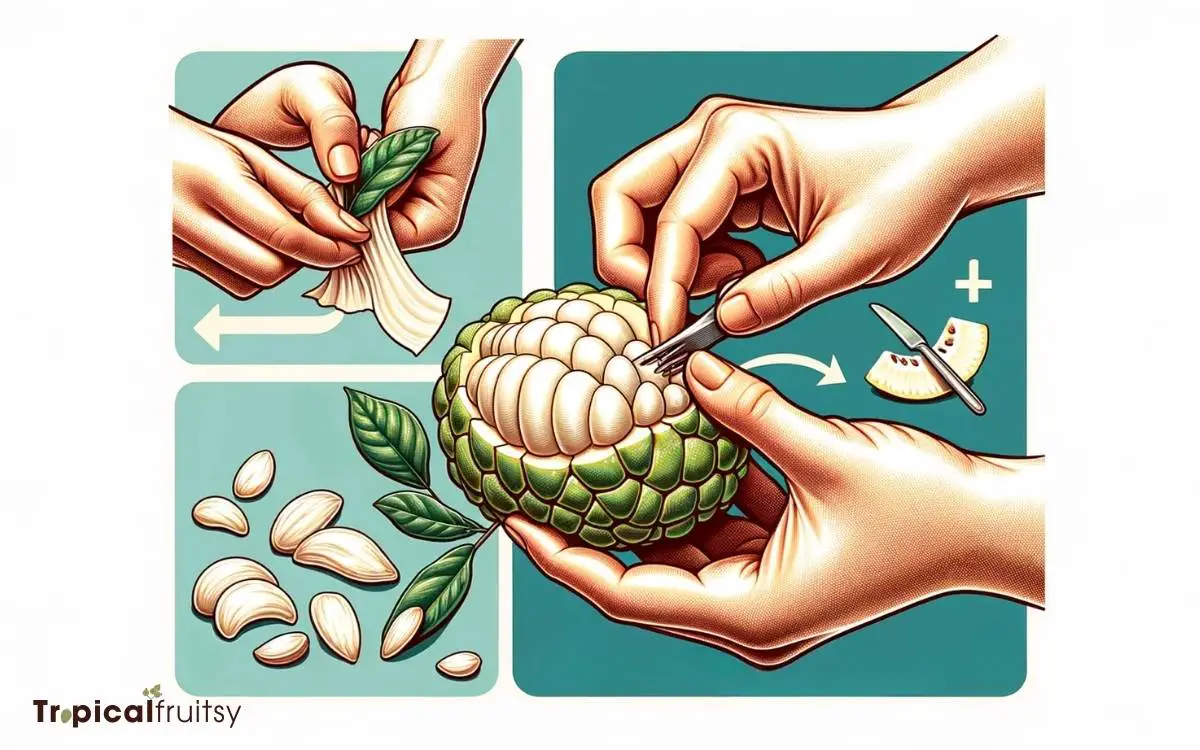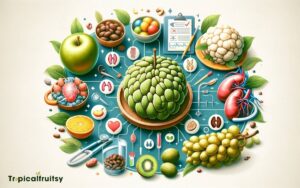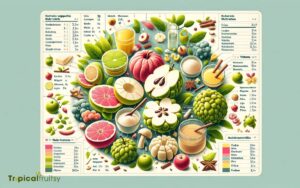How to Eat Custard Apple? 6 Easy Steps!
To eat a custard apple, first, rinse the fruit under running water. Then, cut the fruit into two halves with a knife. Use a spoon to scoop out the creamy flesh, avoiding the black seeds.
Discard the seeds and enjoy the sweet, custard-like pulp directly from the skin or add it to fruit salads, smoothies, or desserts.
Eating a custard apple, also known as a cherimoya or sugar apple, involves a straightforward process.
Here is a detailed explanation with steps:
Custard apples are a tropical fruit known for their sweet taste that’s reminiscent of a mix between a banana, pineapple, and peach, with a texture similar to custard or creamy yogurt.
Indulge in the lusciousness of a custard apple, a delightful tropical fruit that tantalizes the taste buds with its creamy texture and sweet, nuanced flavor.

Key Takeaway
Step 1: Selecting the Right Fruit
Choosing the perfect custard apple, I look for one that’s firm yet gives slightly under gentle pressure, signaling ripeness without being overripe.
The skin should be blemish-free, indicating the fruit hasn’t been mishandled, which can affect taste and longevity.
I also check the color – it should be a consistent pale green without large brown spots, though some speckling is normal.
A good sniff at the stem end can reveal a subtle sweet fragrance; if it’s strong, the fruit might be too ripe.
Custard apples are packed with vitamins C and A, fiber, and potassium, making them great for my immune system, eyesight, and digestion. I’m mindful of these health benefits when I choose this nutritious tropical fruit.
Step 2: Understanding Ripeness Indicators
In assessing a custard apple’s ripeness, I look for subtle changes in the fruit’s texture and aroma. A ripe custard apple feels slightly soft under gentle pressure, indicating that the inner flesh is creamy and ready to eat.
It shouldn’t be too hard, as that means it’s underripe, nor should it be overly squishy, which could suggest overripeness or spoilage.
I also sniff the fruit; a mature custard apple emits a sweet, pleasant fragrance. The skin color can be misleading, as it varies with different varieties, but generally, it transitions from green to a lighter shade.
I’m mindful that consuming fruit at its peak ripeness maximizes nutritional benefits, like the full spectrum of vitamins, fiber, and antioxidants custard apples offer. Hence, recognizing these ripeness cues is crucial for the best eating experience.
Step 3: Washing and Preparing
Before I slice into the custard apple, I ensure it’s thoroughly washed to remove any surface contaminants. I use a gentle scrub under running water, being careful not to bruise the delicate skin.
Next, I’ll outline the best cutting technique to access the creamy flesh while minimizing waste.
Rinse Techniques
I start the custard apple preparation with a thorough rinse, ensuring any dirt or residues are washed away before consumption. It’s important to remove any potential contaminants that could pose health risks.
I gently run cool tap water over the fruit’s surface, turning it in my hands to reach all sides. If there’s visible dirt or debris, I’ll use a soft brush to scrub lightly, taking care not to bruise the delicate skin.
Once it’s clean, I pat the custard apple dry with a clean towel. This step prevents bacterial growth and prepares the fruit for eating or slicing.
My focus on cleanliness ensures that I can enjoy the fruit’s health benefits without the worry of ingesting harmful substances.
Cutting Methodology
Having completed the rinse process, I’ll now move on to the cutting methodology, starting with how to properly slice into the custard apple.
It’s important to use a clean cutting board and a sharp knife to avoid contamination and ensure a smooth cut.
I carefully cut the fruit in half, vertically right through the stem, to expose the creamy interior and seeds.
It’s crucial to remove the seeds, as they aren’t edible—doing this meticulously ensures that I can enjoy the fruit safely and fully. I make sure not to apply too much pressure, which can crush the delicate flesh.
Step 4: How to Cut a Custard Apple
Mastery of the proper cutting technique ensures a mess-free enjoyment of a custard apple’s creamy texture. I always start by giving the fruit a good wash.
Then, I place it on a cutting board and slice it in half, exposing the flesh packed with nutrients essential for a healthy body.
Here’s a simple table to guide you:
| Method | Description |
|---|---|
| Horizontal Cut | Slice the fruit horizontally around the middle and twist open. |
| Vertical Cut | Cut the fruit from stem to bottom and pull apart. |
| Wedge Cut | Make a series of cuts from the top and remove wedges. |
Each method reveals the fruit’s segments, making it easier to remove the seeds and indulge in the antioxidant-rich, fibrous sweet flesh. Remember, a sharp knife is key to a clean cut.
Step 5: Removing the Seeds
As we move on to removing the seeds from a custard apple, it’s crucial to know that these seeds aren’t edible and must be discarded to enjoy the creamy flesh safely.
I’ll guide you through various seed extraction methods, ensuring you can separate the seeds without losing much of the nutritious fruit.
We’ll also compare the spitting versus scooping techniques, so you can choose the most health-conscious and efficient method to relish this tropical treat.
Seed Extraction Methods
I’ll show you three effective methods to remove the seeds from a custard apple for a hassle-free eating experience. Eating this fruit should be as delightful as its creamy texture and sweet taste, so let’s focus on making it seedless:
- Manual Picking: After cutting the fruit open, use your fingers to gently pull out the seeds as you eat or scoop the flesh.
- Blending & Straining: Blend the pulp and then pass it through a sieve to separate the seeds from the creamy flesh.
- Slit and Squeeze: Make a small slit in each segment and squeeze it so that the seed pops out, leaving the flesh intact.
Edible Parts Identification
Having removed the seeds, you’re now left with the purely edible parts of the custard apple: the creamy flesh that’s both fragrant and sweet.
This flesh isn’t only a delight to the taste buds but also packed with essential nutrients. It’s rich in dietary fiber, which promotes good digestive health and helps maintain a feeling of fullness, aiding in weight management.
The flesh also contains vitamin C, an antioxidant that supports the immune system and skin health, and vitamin B6, which is vital for brain function and mood regulation.
Magnesium and potassium found in the custard apple contribute to heart health, while its low glycemic index makes it suitable for those monitoring their blood sugar levels.
Enjoy this delicious fruit knowing it’s nourishing your body.
Spitting Vs Scooping Techniques
Before enjoying the custard apple’s creamy flesh, I’ve got to choose between two methods for removing its numerous seeds: spitting them out as I eat or scooping them out beforehand.
Here’s what I consider when making my choice:
- Health: Scooping eliminates the risk of accidentally swallowing seeds, which can be a choking hazard.
- Convenience: Spitting is straightforward but can be messy, while scooping requires a bit of prep work.
- Taste Experience: Eating without interruption enhances the enjoyment of the fruit’s flavor.
- Waste Reduction: Scooping allows me to ensure I’m not leaving behind any of the delicious flesh.
I prefer scooping to avoid any health risks and to savor every bit of the custard apple without interruption. It takes a bit more time, but it’s worth it for a safe and pleasurable eating experience.
Step 6: Ways to Consume
Cutting into the soft, creamy flesh of a custard apple, I’ve discovered several delightful ways to enjoy this unique fruit. Eaten fresh, it’s a nutritious snack, packed with vitamin C and dietary fiber, which supports digestive health.
I often scoop out the flesh and blend it into smoothies for a tropical twist or mix it into yogurt for a probiotic-rich breakfast.
The custard-like texture also makes it perfect for dessert recipes, such as mousses or ice creams, providing natural sweetness and a boost of antioxidants.
For a savory twist, I’ve added it to salads, pairing it with leafy greens for added minerals and vitamins.
Can Custard Apple be Used in Different Dessert Recipes Besides Eating it Raw?
Yes, custard apple can be used in various dessert recipes besides eating it raw. One popular option is the apple crumble with custard recipe, which combines the delicious flavor of custard apple with a crunchy, sweet crumble topping. This versatile fruit can add a unique twist to any dessert.
Storing Leftovers
My custard apple’s remaining flesh can be stored in the refrigerator, tightly wrapped, to maintain its freshness for a few days.
When I’m dealing with leftovers, I make sure they stay edible and retain their nutritious value by following these simple steps:
- Place in an airtight container: This minimizes exposure to air, which can degrade the quality.
- Remove the seeds: They can be bitter and aren’t pleasant to eat.
- Squeeze a little lemon juice on top: This helps prevent browning and adds a zesty flavor.
- Label with the date: Keep track of how long it’s been stored to ensure I’m enjoying it while it’s still good.
Health Benefits Explored
Delving into its health benefits, one can’t help but be impressed by the custard apple’s nutritional profile, packed with vitamins, minerals, and fiber. It’s a powerhouse of vitamin C, vital for a robust immune system and glowing skin.
The fruit’s high magnesium content helps maintain a healthy heart rhythm and keeps muscles functioning properly. Custard apples are also rich in potassium, which can aid in controlling blood pressure levels.
Moreover, the presence of dietary fiber in custard apples promotes digestive health and may prevent constipation.
The antioxidants found in custard apples, such as vitamin A and flavonoids, support eye health and can combat the damaging effects of free radicals, reducing the risk of chronic diseases.
Eating custard apples isn’t only a treat for the taste buds but also a boon for overall wellness.
Conclusion
In wrapping up, I’ve found that including custard apples in my diet isn’t just delightful but also smart for my health.
Interestingly, one study shows that these fruits are packed with anti-inflammatory properties, which is great considering chronic inflammation is linked to many diseases.
By carefully selecting, preparing, and savoring custard apples, I’m indulging in a treat that’s as beneficial as it’s delicious—truly a win-win for my taste buds and wellbeing.






